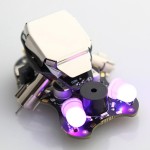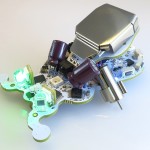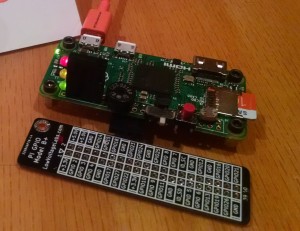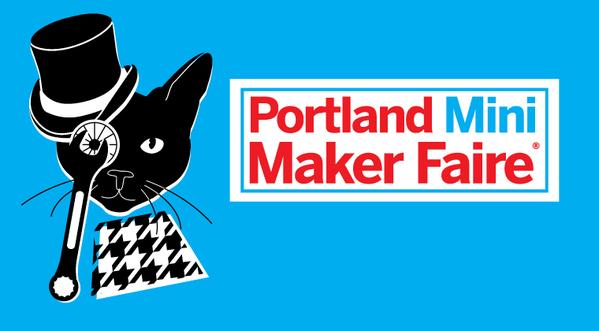Plum Geek Robotics products are now part of the Low Voltage Labs family of STEM products
Low Voltage Labs LLC, a maker of STEM products for Raspberry Pi and soldering kits, has purchased the line of robots from Plum Geek Robotics. Low Voltage Labs owner Eric Thompson will continue to work with Kevin King, the creator of the Plum Geek robots, to ensure the smooth transition of Low Voltage Labs taking over the robotic product line.
 Low Voltage Labs is already manufacturing WinkBot, and expect to have the first robots available in mid-April of 2019. WinkBot, a robot that is programmed with Arduino, can use basic programming to follow lines, seek lights, detect barriers, and more. It is the perfect robot for those learning to program code. Users learn the basics of the C language in a fun, non-complicated way.
Low Voltage Labs is already manufacturing WinkBot, and expect to have the first robots available in mid-April of 2019. WinkBot, a robot that is programmed with Arduino, can use basic programming to follow lines, seek lights, detect barriers, and more. It is the perfect robot for those learning to program code. Users learn the basics of the C language in a fun, non-complicated way.
 Low Voltage Labs has also started production on the Ringo robot. Also programmed with Arduino, Ringo was designed to inspire people learning to write code to breath life and real personality into their own robotic pet. Ringo is loaded with sensors, allowing users to code hundreds of possible behaviors. Ringo will be available in May of 2019.
Low Voltage Labs has also started production on the Ringo robot. Also programmed with Arduino, Ringo was designed to inspire people learning to write code to breath life and real personality into their own robotic pet. Ringo is loaded with sensors, allowing users to code hundreds of possible behaviors. Ringo will be available in May of 2019.
For more information on STEM kits or robots, please visit lowvoltagelabs.com.
Speaking at the 2017 Bay Area Maker Faire
I’ve been accepted to speak at the 2017 Bay Area Maker Faire for two presentations.
Sunday, May 21st, 2017
LOCATION: Zone 2 in MAKE: Electronics
TIME: 11:30 am – 12:00 pm
Learn to program hardware with a $5 Raspberry Pi Zero and $8 in parts
http://makerfaire.com/maker/entry/60149/

Sunday May 21st, 2017
LOCATION: Zone 2 in MAKE: Electronics
TIME: 3:00 pm – 3:15 pm
Breakout Bricks a new twist on surface mount breakout boards from Low Voltage Labs
http://makerfaire.com/maker/entry/60160/

Low Voltage Labs at the Portland Mini Maker Faire 2016
 Low Voltage Labs will have a booth at the Portland Mini Maker Faire again this year!
Low Voltage Labs will have a booth at the Portland Mini Maker Faire again this year!
We will be demonstrating our open source hardware products for the Arduino and Raspberry Pi platforms as well as easy to solder electronics kits.
Find out more at OMSI’s website:
http://www.omsi.edu/maker-faire-pdx
Date: September 10-11, 2016
Time: 10am-5pm
Cost: $15 adults, $10 youth and seniors
Located at: OMSIMaker Faire is the Greatest Show (and Tell) on Earth—a family-friendly showcase of invention, creativity and resourcefulness, and a celebration of the Maker movement. It’s a place where people show what they are making, and share what they are learning.
Makers range from tech enthusiasts to crafters to homesteaders to scientists to garage tinkerers. They are of all ages and backgrounds. The aim of Maker Faire is to entertain, inform, connect and grow this community.
Low Voltage Labs at the Portland Mini Maker Faire 2015
Low Voltage Labs at the Portland Mini Maker Faire 2015
 Low Voltage Labs will have a booth at the Portland Mini Maker Faire again this year!
Low Voltage Labs will have a booth at the Portland Mini Maker Faire again this year!
We will be demonstrating our open source hardware products for the Arduino and Raspberry Pi platforms as well as easy to solder electronics kits.
Find out more at OMSI’s website:
http://www.omsi.edu/maker-faire-pdx
Date: September 12-13, 2014
Time: 10am-5pm
Cost: $15 adults, $10 youth (3-13) and seniors (63+)
Located at: OMSIMaker Faire is the Greatest Show (and Tell) on Earth—a family-friendly showcase of invention, creativity and resourcefulness, and a celebration of the Maker movement. It’s a place where people show what they are making, and share what they are learning.
Makers range from tech enthusiasts to crafters to homesteaders to scientists to garage tinkerers. They are of all ages and backgrounds. The aim of Maker Faire is to entertain, inform, connect and grow this community.
Slides from my 2015 Bay Area Maker Faire presentation
On May 16th, 2015 at the Bay Area Maker Faire I did a presentation on designing a Raspberry Pi HAT using KiCAD running on the Raspberry Pi 2.
If you are interested in the slides from the presentation you can see them here.

Presentation page
Meta Pi: Design a Raspberry Pi HAT using KiCAD running on the Raspberry Pi 2
Presentation description
A step-by-step guide to creating a Raspberry Pi HAT using the KiCAD suite of EDA tools running on the Raspberry Pi 2 itself.
The KiCAD project is an open source suite of EDA tools. KiCAD runs on Linux and the new Raspberry Pi 2 now has enough processing power to run KiCAD. KiCAD includes tools for schematic capture, netlist creation, printed circuit board (PCB) layout and a gerber viewer.
This presentation will cover:
– What is a HAT?
– Requirements for a HAT to be called a Raspberry Pi HAT
– Installing KiCAD on the Pi
– Drawing a schematic in KiCAD
– PCB layout in KiCAD
– Creating gerbers files
– Get your HAT PCB built









